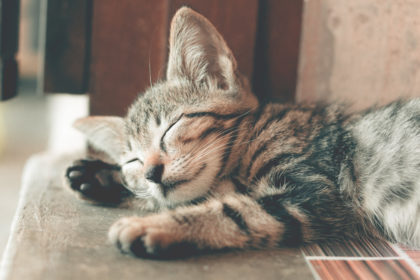
We’ve met talking dogs and the humans who listen to them, so now it’s time to give cats a say. Instead of having the cats use buttons and recordings to express words and phrases in human languages, the humans have to figure out the nuances of feline communication. Turns out, we can do pretty well, especially if we’ve been around cats before. And for that research, Susanne Schötz, Robert Eklund, and Joost van de Weijer won this year’s Ig Nobel Prize in Biology. Arguably, the Ig Nobels are more representative of ordinary science than what makes headlines and certainly what wins Nobel Prizes. Creation is full of mysteries; they don’t all have to be flashy to be worth exploring.
I led with the cats because they are photogenic, but I think my favorite winner was the rhino research. Black rhinos are endangered and conservationists sometimes need to move them around as part of their efforts to preserve populations. That can mean airlifting the rhinos, a stressful experience presumably for everyone and definitely for the animals. So the question is, how to make the flight as comfortable as possible. To test that, rhinos were suspended in different positions and discovered that being suspended upside-down by their feet permitted breathing closest to normal, as measured by blood oxygen. An intercontinental collaborative earned a prize in Transportation. You can play up the humor, but I imagine this work is also motivated by compassion for these animals and a desire to steward them well. Those are values worthy of a prize too.
Other studies may be harder to relate to on its face. Maybe only a microbiologist could be interested in the bacterial ecosystems of discarded chewing gum; still, there’s a lot of old gum lying around in cities and understanding how it does or doesn’t break down could be useful. Few of us will ever serve on submarines, but presumably we can appreciate why those who do would want to control the onboard cockroach population. Tracking what audiences smell like as they watch movies? Apparently someone thinks that can provide a better way to rate films by sensing how people are responding physiologically. And hey, they’ve made their data available online if anyone wants to see if there are other interesting patterns. I don’t know if you can replicate any Nobel Prize winning research at home, but here’s a chance to follow in the footsteps of Ig Nobel winners.
There’s a light-heartedness to the Ig Nobels, but I am serious about that last bit. Even if cinema scents aren’t your thing, there are plenty of scientists publishing their data and/or code to give all of us a chance to try our hands at science. If you any interest in a science career, or just want to see what the work of science is like, there are plenty of opportunities out there. And if you need help figuring out how to start or how to keep going, let me know and I’ll see what I can do.
If you are a woman in science, or think you might want to be, check out this upcoming online event. And if that’s not you, share with someone who is.

Andy has worn many hats in his life. He knows this is a dreadfully clichéd notion, but since it is also literally true he uses it anyway. Among his current metaphorical hats: husband of one wife, father of two teenagers, reader of science fiction and science fact, enthusiast of contemporary symphonic music, and chief science officer. Previous metaphorical hats include: comp bio postdoc, molecular biology grad student, InterVarsity chapter president (that one came with a literal hat), music store clerk, house painter, and mosquito trapper. Among his more unique literal hats: British bobby, captain’s hats (of varying levels of authenticity) of several specific vessels, a deerstalker from 221B Baker St, and a railroad engineer’s cap. His monthly Science in Review is drawn from his weekly Science Corner posts — Wednesdays, 8am (Eastern) on the Emerging Scholars Network Blog. His book Faith across the Multiverse is available from Hendrickson.

I love the Ig Nobel Prizes.